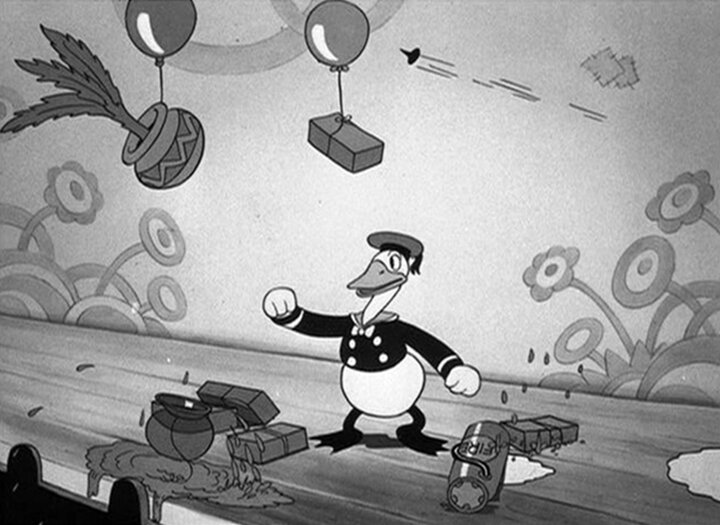When you think of Disney characters like Mickey Mouse and Donald Duck, most people automatically assume Walt himself created those characters. After all why wouldn’t you think that? When you search online “Who created Donald Duck” Google will tell you exactly that. That it was Walt. But the truth is a little bit more complicated.
As far as Mickey goes, you can largely thank Ub Iwerks for the early drawings. With Walt doing his voice.
But I want to talk about Donald specifically because that’s where it gets more confusing. We all know what Donald Duck became eventually, how he looks and sounds. But early on the character looked quite a bit different. The first cartoon where Donald appeared was called “The Wise Little Hen” in 1934. So you would figure, whoever drew Donald in that must have been the creator of Donalds likeness right? For that short, there were several animators who were involved in bringing him to life. Wolfgang Reitherman animated the hen. While Art Babbitt was the one who animated the pig and Donald. So is that it then? Art Babbitt? Well, he only animated the first scene with Donald.
The second scene where Donald has a belly ache was done by Gilles de Tremaudan. While Dick Huemer animated the whole finale of the short.
There was another animator named Dick Lundy who primarily animated Donald in his second cartoon appearance entitled Orphans Benefit.
Many sources say that this was the first story concept created to feature Donald, but it took longer to actually get produced as a cartoon. So the Wise Little Hen was released to the public first.
But since Orphans Benefit was in development first, does that actually mean that Dick Lundy was the first to work on Donald? Welp, again, not really. In part because the Wise Little Hen may still have been animated first. But either way, because before you do animation you need to first design the character and to do that – they first make model sheets for the characters.
From what I have read, Albert Hurter did the first Donald model sheets, which ended up being made for The Wise Little Hen. But what were Hurter’s influences? The plot idea that became Orphan’s Benefit called for Donald being a young character, a cranky little boy forced to recite “Mary Had a Little Lamb” on stage. Since he was a little boy, Donald was drawn wearing a sailor suit, which schoolboys were often depicted as wearing in the early 1900s. The comic strip artist Richard Outcault had introduced Buster Brown, a school-age little boy who wore a sailor suit. The comic strip artist Lansing Campbell drew comics of Uncle Wiggily, a rabbit cartoon character whose friend Jimmy Wibblewobble was a school-age little boy DUCK in a sailor suit.
So there you have it. Alburt Hurter seems to be the first to have drawn Donald Duck right? Well, there is still a bit more to this story, because Hurter’s Donald seemed to have preexisting influences. And you might be thinking, WHAT ABOUT WALT?!
Well, Disney had the name Donald Duck kicking around in the studio for a few years even before the first animated shorts. So he had the desire for this duck to come into existence but it was his artists and animators who made it happen.
There was also a voice artist named Clarance Nash. He would do animal impressions his whole life and one day auditioned these voices for the studio. Walt was impressed with his goat voice, but thought it sounded more like a duck. Nash imitated the goat in the role of a bratty little boy, struggling to recite “Mary Had a Little Lamb” on a stage—that’s where what became the Orphans Benefit concept came from. So Walt knew he wanted to have a bratty child duck character with a bad temper, and ended up using Nash’s goat voice for Donald.
And even before the first shorts, Nash performed “Mary Had a A Little Lamb” as Donald on a Disney-themed NBC radio broadcast in 1934. Which would be the first time the public at large heard Donald’s voice.
“The Wise Little Hen” came out in June 1934. And this Radio broadcast was a few months earlier, in March. So Donald was living on the Radio even before the animated shorts. Possibly even before the model sheets were drawn up.
But guess what, the story doesn’t end there. Because Donald actually existed several years even before this 1934 radio broadcast!
In 1932, a character called Donald Duck appeared in a British Disney children’s book. “Mickey Mouse Annual #3” In a story called “Mickey’s HooZoo”. He only appears on one page of the story, just long enough to be named as one of Mickey’s friends, but he’s there. The art there was done by Wilfred Haughton.
And we’re not done yet. A year before that, in 1931 Disney had released a book called “The Adventures of Mickey Mouse”. Donald Duck is called by name in the book and there are drawings of him, even though he looks entirely different.
Here’s how he appears on the back cover, which I believe to be the first drawing of Donald Duck.
Some of the art was done by Roy Nelson who had also assisted on the Mickey Mouse daily cartoon strip. The artists are unknown but some of the art looks like it could have been Earl Duvall’s work, who had worked on Disney newspaper comics and later some Warner Bros shorts like Honeymoon Hotel.
All in all, it seems that Donald Duck’s creation was truly a fusion of several different animators and illustrators to bring us the character we now know today.
Thanks to David G for research help.







